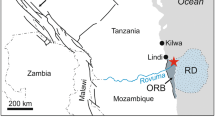Abstract
Scleractinian reef corals have been acknowledged as the most numerous host group for associated hydroids belonging to the genus Zanclea. To date, their geographical distribution is known to include several Indo-Pacific regions. During the Statia Marine Biodiversity Expedition to St. Eustatius (Lesser Antilles, Dutch Caribbean), the Zanclea-coral association was observed for the first time for the Caribbean Sea as well as for the Atlantic Ocean. Our findings confirm that the biodiversity associated with coral reefs remains insufficiently explored worldwide.
Similar content being viewed by others
Avoid common mistakes on your manuscript.
Scleractinian reef corals have been acknowledged as the most numerous host group for associated hydroids belonging to the genus Zanclea (Montano et al. 2015). Recently, various new geographical localities and host records have been published for these animals despite their small size (∼1 mm length), which makes them nearly undetectable in the field. To date, their geographical distribution is known to include several Indo-Pacific regions, such as the Red Sea, the Republic of Maldives, Indonesia, Australia, Taiwan and Japan (Boero et al. 2000; Pantos and Bythell 2010; Hirose and Hirose 2011; Fontana et al. 2012; Montano et al. 2014, 2015).
During the Statia Marine Biodiversity Expedition to St. Eustatius (Lesser Antilles, Dutch Caribbean) in June 2015, two colonies of the scleractinian reef coral Orbicella faveolata (Ellis and Solander, 1786) were observed to host Zanclea hydroids at 16 and 41 m depth (Fig. 1) by applying the roving diver technique. This association appeared to be uncommon in the waters around St. Eustatius, and these records are the first of a Zanclea-coral association for the Caribbean Sea as well as for the Atlantic Ocean.
In addition to a total of 33 species and 24 genera of Scleractinia recorded from the Indo-Pacific (Montano et al. 2015), the Atlantic Orbicella faveolata represents the 34th coral species and 25th scleractinian genus recorded as hosting a Zanclea species. Moreover, Orbicella belongs to the Merulinidae, which is now known to include six Indo-Pacific genera and one Atlantic genus of Zanclea-hosting corals, which equals the maximum number of seven already noted for the Indo-Pacific family Fungiidae (Montano et al. 2015).
Furthermore, the present observation constitutes the deepest record of a coral-associated Zanclea so far, implying that additional host species can be found when mesophotic reef zones (>30 m deep) are explored during future surveys. This finding suggests that this kind of association may have a circumtropical distribution and that insufficient search effort has prevented a full understanding of its distribution on tropical coral reefs.
References
Boero F, Bouillon J, Gravili C (2000) A survey of Zanclea, Halocoryne and Zanclella (Cnidaria, Hydrozoa, Anthomedusae, Zancleidae) with description of new species. Ital J Zool 67:93–124
Fontana S, Keshavmurthy S, Hsieh HJ, Denis V, Kuo C-Y, Hsu C-M, Leung JKL, Tsai W-S, Wallace CC, Chen CA (2012) Molecular evidence shows low species diversity of coral-associated hydroids in Acropora corals. PLoS ONE 7(11):e50130. doi:10.1371/journal.pone.0050130
Hirose M, Hirose E (2011) A new species of Zanclea (Cnidaria:Hydrozoa) associated with scleractinian corals from Okinawa, Japan. J Mar Biol Assoc UK 92:877–884
Montano S, Galli P, Maggioni D, Seveso D, Puce S (2014) First record of coral-associated Zanclea (Hydrozoa, Zancleidae) from the Red Sea. Mar Biodiv 44:581–584
Montano S, Seveso D, Galli P, Puce S, Hoeksema BW (2015) Mushroom corals as newly recorded hosts of the hydrozoan symbiont Zanclea sp. Mar Biol Res 11:773–779. doi:10.1080/17451000.2015.1009467
Pantos O, Bythell JC (2010) A novel reef coral symbiosis. Coral Reefs 29:761–770
Acknowledgments
Fieldwork participation of the first author was funded through a Martin Fellowship from Naturalis Biodiversity Centre. St. Eustatius Marine Parks (STENAPA), Caribbean Netherlands Science Institute (CNSI) and Scubaqua Dive Centre provided logistic support. Finally, we are very grateful to two anonymous reviewers for their constructive comments.
Author information
Authors and Affiliations
Corresponding author
Additional information
Communicated by J. D. Reimer
Rights and permissions
About this article
Cite this article
Montano, S., Galli, P. & Hoeksema, B.W. First record from the Atlantic: a Zanclea-scleractinian association at St. Eustatius, Dutch Caribbean. Mar Biodiv 47, 81–82 (2017). https://doi.org/10.1007/s12526-015-0432-7
Received:
Revised:
Accepted:
Published:
Issue Date:
DOI: https://doi.org/10.1007/s12526-015-0432-7





